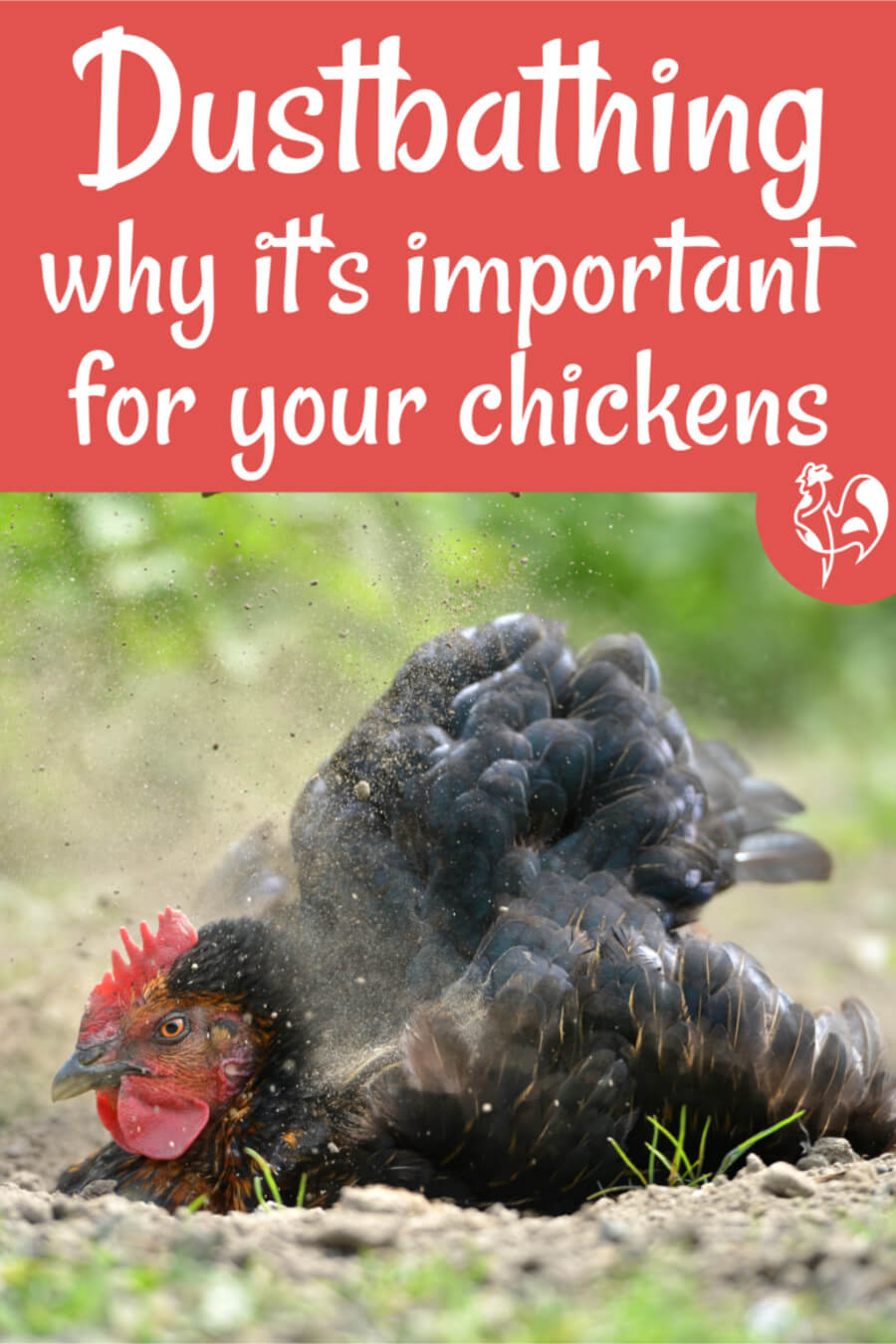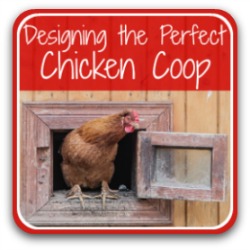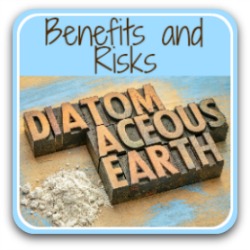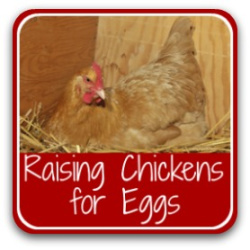Dust baths: why your chickens need one, how to make it and which materials work best?
Dust bathing has long been recognised as something chickens need to do for their own welfare.
But what exactly does it mean, how can we make one that properly fulfills our flock's needs, and what's proven to be the absolute best material to use?
The first time you see it, you may be a bit startled. It can look like your chicken is having some kind of seizure.
Actually, they're simply indulging in a natural behaviour which is critical for their health and well-being.
In this article, we'll look at what dustbathing means, why it's so important, what a dust bath should contain and how to make one easily at home.
What is a dust bath and what does dust bathing mean?
A dust bath is just a place where chickens (and other animals) go when they want to indulge in one of their favourite - and important - pastimes: dust bathing.
It's considered such a critical activity for a chicken's welfare that in Europe, even chickens kept in battery farms must now have access to a place to dust bathe. Providing what are called "enriched cages" has been a legal requirement since January 2012.
Chickens who are dust bathing go through a pattern of behaviour:
- They find a spot they like and, using their beak and feet to scrape away the soil (or whatever material there is), they make a hollow.
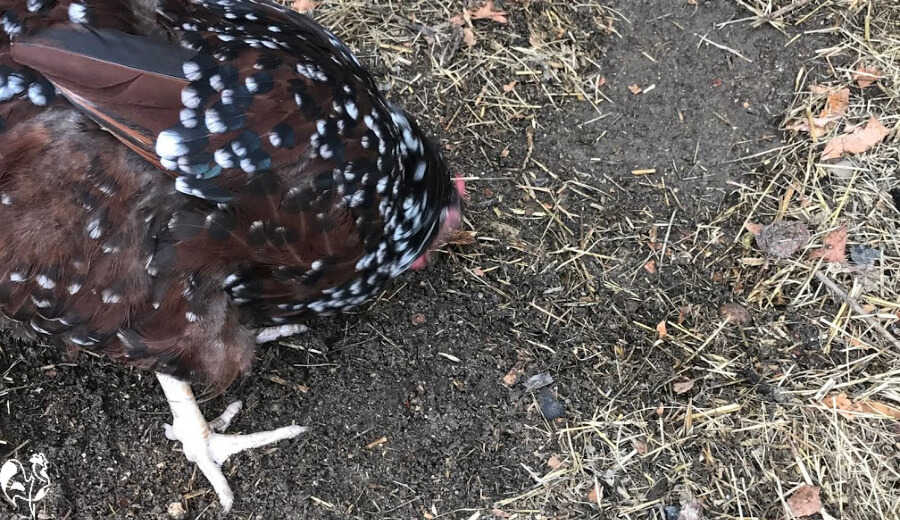 First, hollow out a spot! One of my Speckled Sussex hens prepares for a dust bath.
First, hollow out a spot! One of my Speckled Sussex hens prepares for a dust bath.- The hen (males do this too) fluffs out her feathers and sits down. Sitting or lying on one side, she flicks the soil onto her feathers, using her head, feet and wings. She'll also rub her head in the soil to cover those feathers at the same time.
- She will then turn over and do the other side!
- The soil works its way into the feathers and becomes attached to loose material that needs removing: mites and other parasites, skin cells, dead or loose feathers and oils.
- The final stage is the hen standing up and shaking to remove the soil, together with everything it's picked up.
Want to see it in action? You can see a variety of those behaviours in this video of a group of my hens who gathered together for a dust bath!
On average, hens will dust bathe once every two days. Studies(e.g. 1) have shown that the process seems to be stimulated by sunlight, so they'll more often have their "spa" in the afternoon, when the land has warmed a little, rather than the morning.
The whole process should take between 20 and 30 minutes. Instinctively knowing how important the process is, a hen will normally take less than this only if disturbed.
Observations of chickens have also shown that dust bathing is a social activity - if they can, our ladies (and gents!) prefer to have their spa day together.
What to do.
- Make sure your flock has a space to dust bathe, if possible large enough for them all to get in together. It might be simply a patch of loose soil, or a purpose built rig - we'll come to that later.
Why is dust bathing critical for chickens?
We know from studies and our own observations that chickens will try to dust bathe even when they don't have an ideal place to do it.
Why do they instinctively feel it's so important?
Keeping feathers healthy.
One of the most important facts about dustbathing is that it keeps the feathers and skin in good condition.
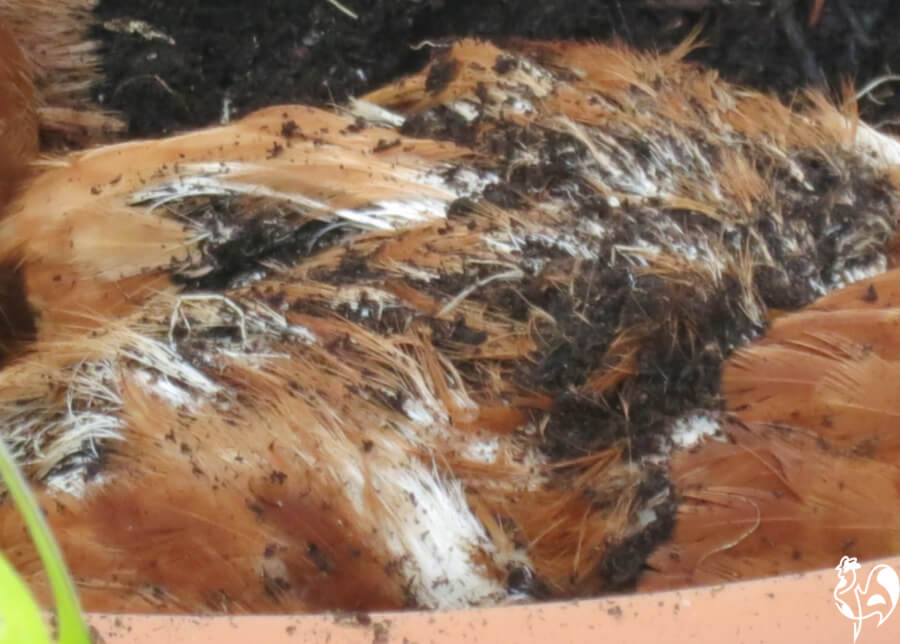 One of my Red Stars, dust-bathing. Soil within the feathers extracts oils and refreshes plumage.
One of my Red Stars, dust-bathing. Soil within the feathers extracts oils and refreshes plumage.Chicken feathers need a certain amount of oils (properly known as 'lipids') to remain water repellent. But as those lipids collect over time, they become stale. They collect along with dead skin cells and broken feathers, and the plumage becomes unable to protect the bird from either water or heat.
Tossing soil or sand into the feathers during dust baths, and preening the feathers by "pulling" the oils from the base with the beak, has been shown to get rid of that excessive build up(2).
The feathers are left clean, the down fluffy and the upper feathers more able to lie properly. The chicken is again able to use her feathers as insulation.
Parasites.
Parasites like lice and mites can be a problem within flocks, and feathers that aren't clean are known to attract them.
Why? Because the lipids we talked about above have been shown to act as food for parasites(2, 3).
So dust bathing is important not only to remove any parasites already there, but to remove the old lipids and skin cells in order to prevent parasites wanting to lodge in the feathers as a kind of eat-in fast foodery.
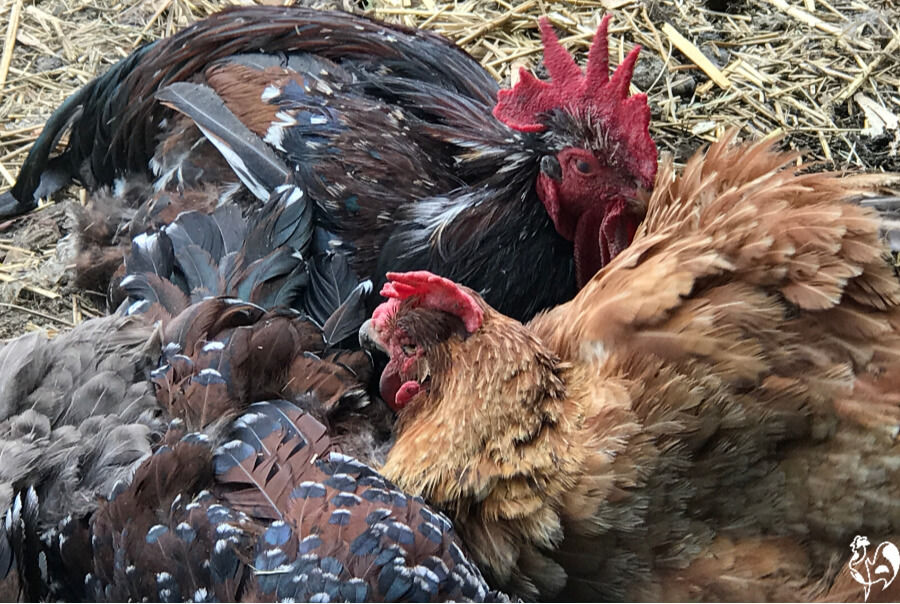 Mr Woo, my Speckled Sussex rooster, after a dust bath with his hens.
Mr Woo, my Speckled Sussex rooster, after a dust bath with his hens.What happens if dust baths aren't available?
We know that chickens will try to dust bath even if they're housed on wire caged floors(1). But if they don't have access to dust baths with some kind of litter, they're much more likely to have issues with parasites and with poor feathering leading to health problems.
There's also evidence that having nowhere to dust bathe will lead to feather pecking. So if you have chickens who are constantly pecking at their own or somebody else's feathers, check whether you have good "spa" facilities available to them.
What to do.
- Simple. Make sure your chickens have enough room and as much space as possible to have dust baths, and are free to use them as often as they choose.
At what age should chickens be given a dust bath?
Chicks love to dustbathe from a very early age. In fact, a study has shown that they seem to hatch with an instinctive sense of what would make a good substance for dust bathing(4).
In other words, if they see something they think would be good to dustbathe in, they'll go ahead and do it. I've seen this with my own chicks. They never choose to dust bathe in wood shavings but give them sand or peat and there's no stopping them!
Want practical evidence? Take a look at this short video of some of my five day old chicks.
What to do.
- Make sure the chicks in your brooder have a place to dustbathe. The easiest way is to use sand as bedding, or add a small trough full of peat.
What should a dust bath contain?
There have been a lot of scientific research papers about which material (known as "substrate") is best, and their findings are borne out by my own experience.
Here's a summary of what they show.
- Hens prefer small, fine-grained particles to dust bathe(5).
- Hens given woodshavings as dustbathing material and later transferred to sand, increased the time they spent.
- Conversely, hens moved from sand to wood shavings cut their dustbathing time to less than five minutes (6).
- When offered peat (potting compost) or a choice of other materials including sand, sawdust and wood shavings, the chickens chose peat every time(3).
- My chickens know what they're doing - they choose to use my peat-filled pots as dust baths even when they have sand available!
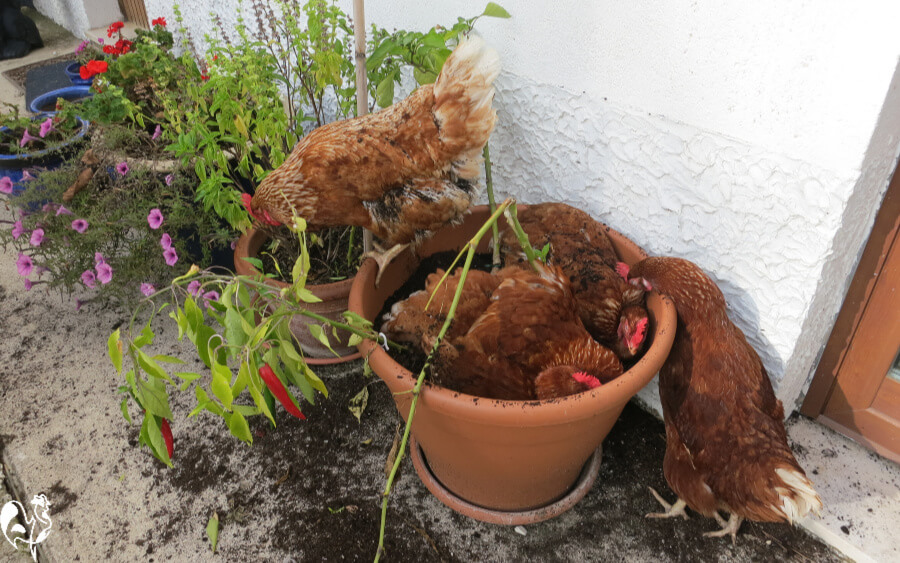 My chickens also prefer peat!
My chickens also prefer peat!When these materials were tested for effectiveness both in terms of cleaning stale lipids and getting rid of parasites, it became clear that chickens instinctively know what's best.
- Wood shavings had no effect either on improving plumage or getting rid of mites.
- Sand was more effective at both than wood shavings.
- Peat was best of all at removing lipids, and because parasites thrive on stale lipids, it was therefore effective as a precaution against mites as well(2, 6).
The best material for dust baths is...
So in order of both preference and effectiveness, the materials chickens will choose for dustbathing are:
First prize: Peat (potting compost)
Runner up: Sand
Not keen: Sawdust
Don't bother: Wood shavings.
Using diatomaceous earth in a dust bath - yes or no?
Diatomaceous earth (DE) is controversial. I've written about why, and what the pros and cons are, in this article. Read it if you plan to use DE in your dust bath.
Evidence from studies(7) is that DE used in a dust box with sand as its base prevented mites after a week's use. But they returned as soon as the dust box was removed.
So use it if you're comfortable with it - but only when mixed with other materials, never on its own.
What to do.
- If possible, use potting compost (peat) for your dust baths. It's expensive, but it's the best.
- Loose garden soil is a reasonable substitute. Or mix it with peat as a compromise.
- Sand is next best.
- Diatomaceous earth can be added to whichever other material you use - but be aware of its issues with respiratory problems.
- Don't use wood ash unless you're very sure you can keep the dust bath bone dry. Wood ash, when wet, burns.
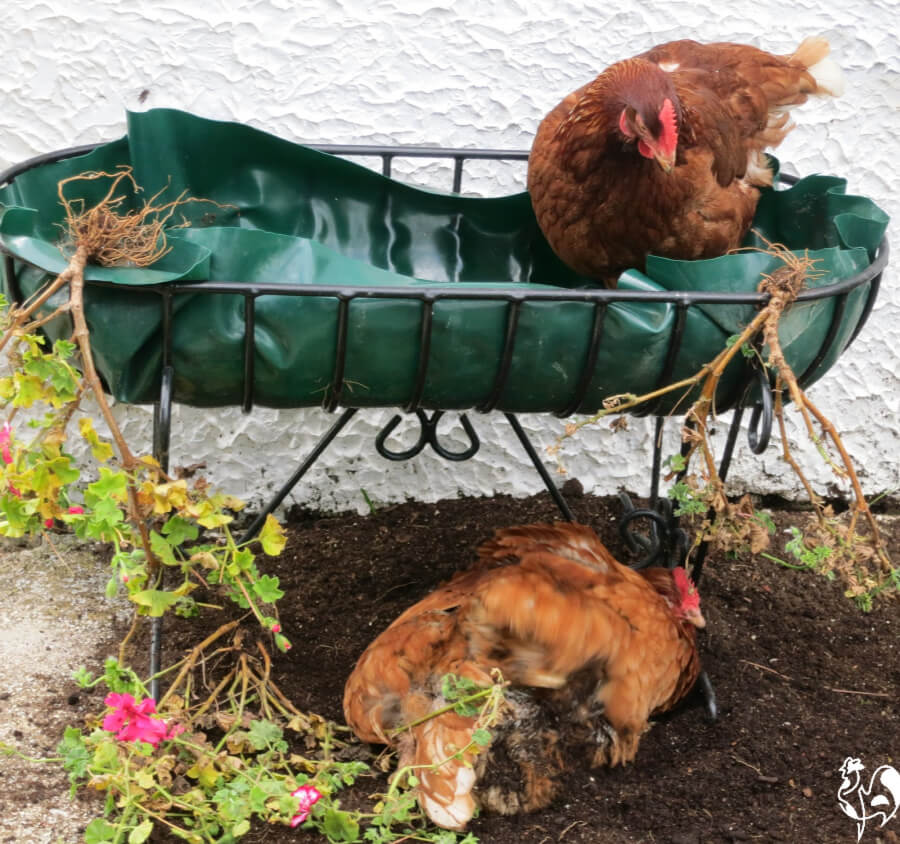 Two of my Red Stars kicking compost from my planter to use as a dust bath.
Two of my Red Stars kicking compost from my planter to use as a dust bath.Building a DIY dust bath: which containers work?
Here's the truth: you can provide as many pretty dust baths as you like. In the end, your chickens are likely to ignore them and find their own preferred spot.
I've used a number of experimental dust baths:
- A circle of wood stumps (pretty, but the material seeped out from between so it didn't last long).
- A circle of large bricks (also pretty and better at retaining sand or compost than the wood)
- Large car tyres (tractor tyres are better if you can get some discarded ones)
- A child's sand pit (too small for many to fit at once, but came with a cover which was handy for protecting it from the rain).
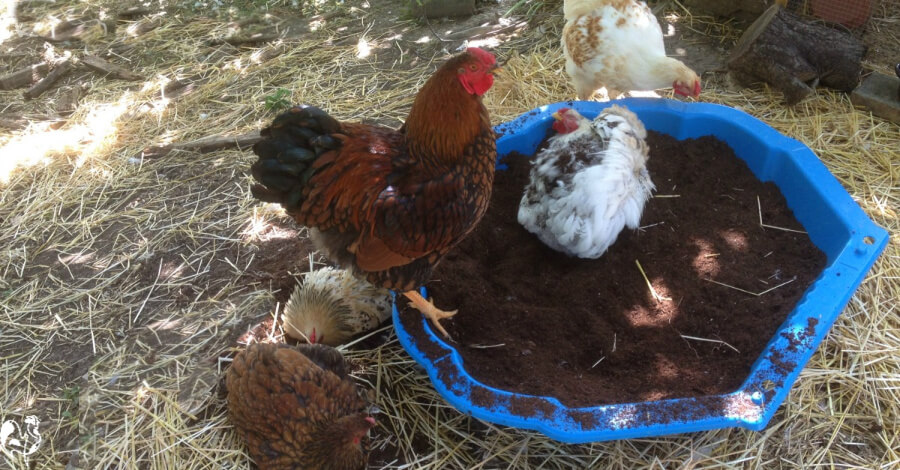 Some of my chickens try out a child's sandpit filled with compost as a dust bath.
Some of my chickens try out a child's sandpit filled with compost as a dust bath.But in the end, my flock decided to use three favourite places: one in the shade of a fig tree; one in the shade of a bay tree and one in full sun which becomes their winter spa!
There are a few pointers from studies which can help us provide the best possible environment.
- The kind of container was irrelevant, but there was a direct correlation between how long chickens dust-bathed and the size of the space. The bigger it was, the better(5).
- Chickens lower in the pecking order are likely to be left out of the group dust bath(1). Having more than one area helps.
- Having the dust bath available to chickens who were, for one reason or another, isolated from the rest of the flock was important. It helps if it can be within sight of the other dustbathing areas. Seeing their friends having a "spa" day encouraged dustbathing in isolated hens(1).
- If chickens can find nothing else to use as a dust bath, they'll use feed(5). Feed is not helpful - it adds, rather than takes away, the lipids that parasites feed on.
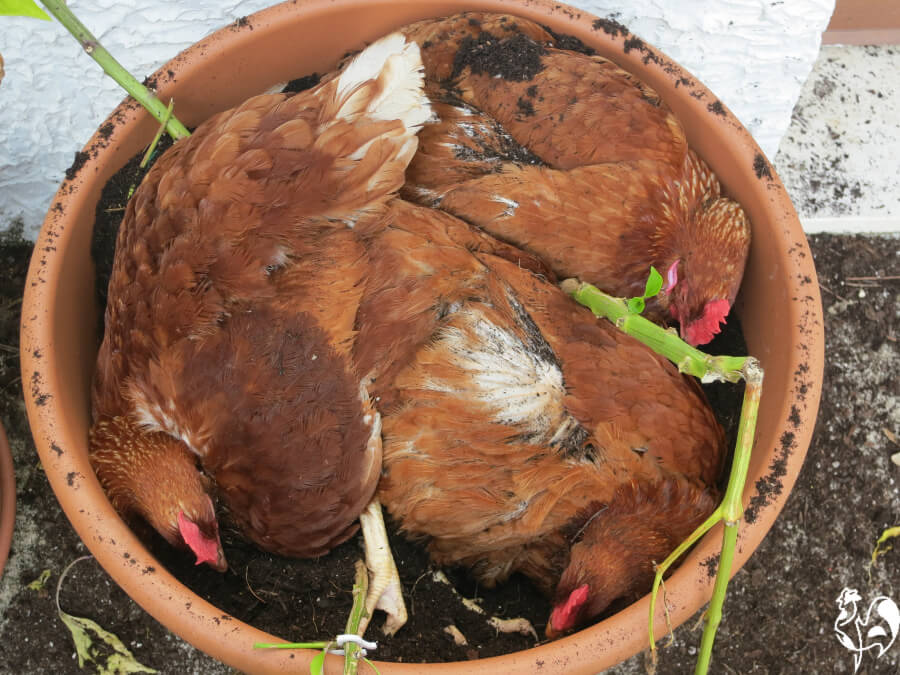 There are three hens in that pot!
There are three hens in that pot!What to do.
- If you have a run with soil, make as large a space as possible available. The ideal would be somewhere in the shade for summer and in sun for winter.
- Having more than one area also allows chickens lower in the pecking order to find their own space away from the competition.
- Make sure it's safe from predators. I use the shade of trees to stop birds of prey; they're also well hidden from foxes and other predators.
- If you have a chicken in isolation, try to persuade them to dust bathe by adding a container into their pen.
- Keep dust baths away from feed areas and waterers.
Enjoy watching your chickens have their spa days!
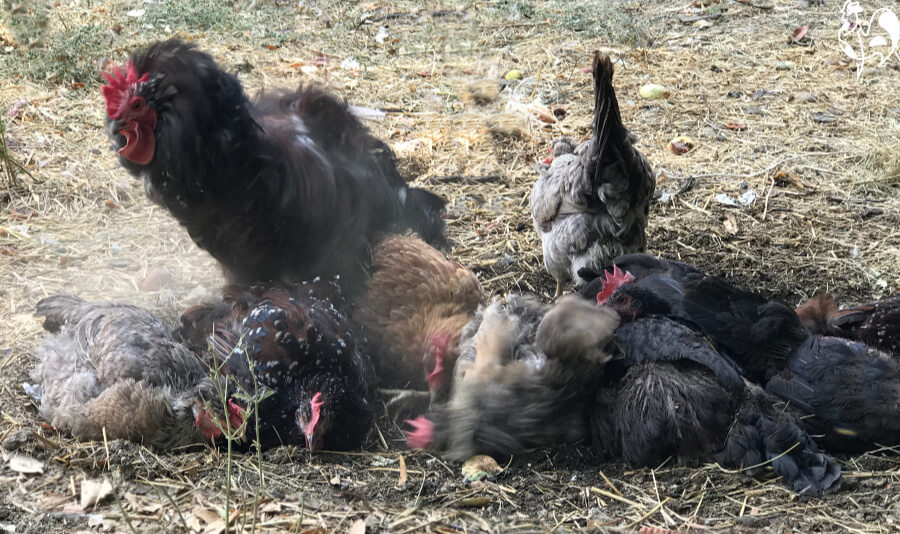 Even a rooster needs a treat! Some of my chickens enjoying their spa day.
Even a rooster needs a treat! Some of my chickens enjoying their spa day.If you found this article useful, you may like these.
Sources.
A lot of "facts" you'll find on the internet are often people's individual views, based on inaccurate information repeated from poor quality sources.
The information I provide in this article and others is based not just on my own experience, but on evidenced facts from scientific, peer-reviewed research and books from highly respected and experienced poultry keepers such as Gail Damerow.
Some of the trusted sources I have used in this article are these.
1. Duncan, I. et al: External factors and causation of dustbathing in domestic hens. Pub. Journal of Behavioural Processes, 1995.
2. Van Liere, D. W: Function and organization of dust bathing in laying hens. Pub. Faculty of Life Sciences, University of Wageningen, Netherlands, 1991.
3. Petherick, J. C. and Duncan, I. J. H.: Behaviour of young domestic fowl directed towards different substrates. Pub. Journal of British Poultry Science, 2007.
4. A. Patherick, J. C. et al: The role of perception in the causation of dustbathing behaviour in domestic fowl. Pub. Journal of Animal Behaviour, 1995.
5. Louton, H., et al: Dust-bathing behaviour of laying hens in enriched colony housing systems and an aviary system. Pub. Journal of Poultry Sciences, 2012.
6. Van Liere, D. W. et al: Dustbathing behaviour of laying hens as related to quality of dustbathing material. Pub. Journal of Applied Animal Behaviour Science, 1990.
7. Martin, C. D. and Mullens, B. A.: Housing and dustbathing effects on northern fowl mites and chicken body lice on hens. Pub. 2012.
